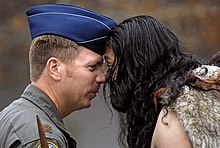Hongi


The hongi (Māori pronunciation: [ˈhɔŋi]) is a traditional Māori greeting performed by two people pressing their noses together, often including the touching of the foreheads.[1] The greeting is used at traditional meetings among Māori people,[2] and at major ceremonies, such as a pōwhiri.[3] It may be followed by a handshake.[3]
In the hongi, the ha (breath of life) is exchanged in a symbolic show of unity.[1][3] Through the exchange of this greeting, manuhiri, visitors, blend with tangata whenua, the people of the land, and establish a connection.[3]
A rāhui (temporary ban) was placed on the use of the hongi by some iwi and rūnanga (tribes and tribal councils) as a result of the COVID-19 pandemic.[4][5]
Symbolism
[edit]When Māori greet one another by pressing noses, the tradition of sharing the breath of life is considered to have come directly from the gods. In Māori mythology, woman was created by the gods moulding her shape out of the earth. The god Tāne embraced the figure and breathed into her nostrils. She then sneezed and came to life, creating the first woman in Māori legends, Hineahuone.[1][6]
Examples
[edit]The hongi may be performed by Māori and non-Māori, and between New Zealanders and foreign visitors. Several British royals have been greeted with the hongi during visits to New Zealand, including: King Charles;[7] Princess Diana;[8] Queen Camilla; Prince William and Kate Middleton;[9] and Prince Harry and Meghan Markle.[10] U.S. Secretary of State Hillary Clinton was greeted with a hongi in November 2010 during her visit to Wellington.[11] Former U.S. President Barack Obama exchanged a hongi during a visit to the country in March 2018.[12] The hongi is used in some churches as a way to share the sign of peace.
Similar practices
[edit]In Native Hawaiian culture, the honi is a practice similar to the Māori hongi, involving touching noses.[13]

In Sabu Raijua, Indonesia, a similar greeting involving touching noses called Henge'do is practiced.[14]
See also
[edit]- Cheek kissing
- Eskimo kissing, a similar gesture
- Māori culture
References
[edit]- ^ a b c Salmons, Matthew (17 September 2017). "Hongi, our national greeting". Stuff.co.nz. Retrieved 1 November 2018.
- ^ The Editors of Encyclopaedia Britannica. "Maori – Maori Culture in the 21st Century". Encyclopædia Britannica. Retrieved 1 November 2018.
- ^ a b c d Māori ki Te Whare Wānanga o Ōtākou. "Pōwhiri". Dunedin: University of Otago. Retrieved 1 November 2018.
- ^ "Coronavirus: No more hongi or handshakes – Ngāti Kahungunu iwi acts to stop spread of Covid-19," New Zealand Herald, 14 March 2020. Retrieved 7 April 2020.
- ^ "Coronavirus: Hongi restriction put in place at pōhiri in Wellington," Radio New Zealand, 5 March 2020. Retrieved 7 April 2020.
- ^ Derby, Mark (September 2013). "Ngā mahi tika – Welcome and hospitality: Origin of the hongi". Te Ara: The Encyclopedia of New Zealand. Retrieved 8 September 2017.
- ^ "Maori warriors greet Prince Charles and Camilla in New Zealand". The Telegraph. 7 November 2015. Retrieved 1 November 2018.
- ^ "Remembering Princess Diana 20 years on". Gisborne Herald. 31 August 2017. Archived from the original on 1 March 2020. Retrieved 1 November 2018.
- ^ Boyle, Danny (12 October 2017). "Prince William shares hongi greeting as he honours Kiwi Passchendaele soldiers". The Telegraph. London. Retrieved 1 November 2018.
- ^ "Meghan praises first female vote in speech". BBC News. 28 October 2018. Retrieved 1 November 2018.
- ^ "Hillary Clinton's First Powhiri Hongi". scoop.co.nz. 2010. Retrieved 26 September 2011.
Scoop Images: Hillary Clinton's First Pōwhiri Hongi
- ^ "Pictures of the Day: 23 March 2018 I". The Telegraph. London. 23 March 2018. Retrieved 1 November 2018.
- ^ "Honi". ulukau HAWAIIAN ELECTRONIC LIBRARY. Retrieved 29 October 2020.
- ^ "Makna di Balik Tradisi Cium Hidung Warga Sabu Raijua". Tempo.co (in Indonesian). Retrieved 10 October 2017.
